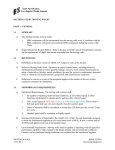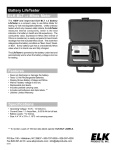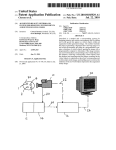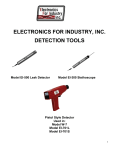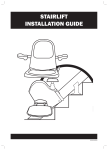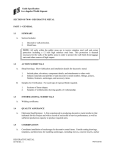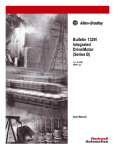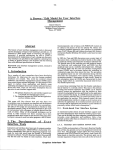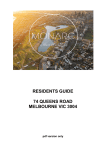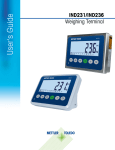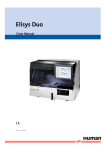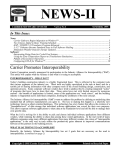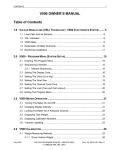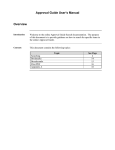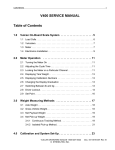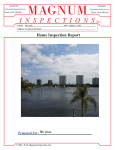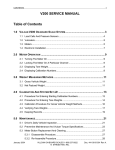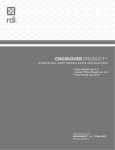Download SECTION 143100 - ESCALATORS - Los Angeles World Airports
Transcript
Guide Specification
SECTION 14 31 00 - ESCALATORS
PART 1 - GENERAL
1.1
SUMMARY
A.
1.2
This Section includes high-traffic, transit type interior escalators.
DEFINITIONS
A.
Definitions in the latest version of ASME A17.1 apply to work of this Section.
B.
High-Traffic Escalators: Escalators designed specifically for use where high-traffic volumes
produce dense occupancy resulting in structural, machinery, and brake loads much higher than
normal.
C.
Defective Escalator Work: Operation or control system failure, including excessive
malfunctions; performances below specified ratings; excessive wear; unusual deterioration or
aging of materials or finishes; unsafe conditions; the need for excessive maintenance; abnormal
noise or vibration; shipping damage; and similar unusual, unexpected, and unsatisfactory
conditions.
D.
C.D. Reference to a device or a part of the equipment applies to the number of devices or parts
required to complete the installation.
1.3
PERFORMANCE REQUIREMENTS
A.
Delegated Design: Design escalators including attachment to structure, including
comprehensive engineering analysis by a qualified professional engineer, using performance
requirements and design criteria indicated.
B.
Operational Requirements: The escalator systems shall:
1.
2.
3.
4.
5.
Be capable of operating under full load conditions, at full contract speed, in either
direction, and designed to operate quietly and smoothly without bounce.
Have a rated nominal speed of 100 ft. /min. (.50 m/s) or metric equivalent. The no-load
to full load speed shall not vary by more than 4% of the contract speed.
Hours of operation shall be considered as twenty-four (24) hours per day, seven (7) days
per week, and 365 days a year.
Direction of travel shall be considered as either direction; and unit shall be up and down
reversible.
Handrail speed shall be consistent with step speed.
C.
Braking Performance: Provide brakes that stop escalator in up-running mode at a rate no
greater than 3 ft. /s2.
D.
Step/Skirt Performance Index: Not more than 0.15.
ESCALATORS
14 31 00 - 1
Revised 12/2011
Conveying Equipment
Guide Specification
E.
Structural and Mechanical Performance for High-Traffic Escalators: For the purpose of
structural design, driving machine and power transmission calculations, and brake calculations,
design high-traffic escalators for loads not less than 2 times the design loads required by
ASME A17.1.
F.
Structural Performance of Balustrades, Deck Barricades, and Handrails: Provide components
and assemblies capable of withstanding the effects of loads indicated in ASCE 7 for handrail
assemblies and guardrail systems.
G.
Regulatory Requirements: Comply with ASME A17.1, CCR Title 8, and escalator design
requirements for earthquake loads in ASCE 7.
1.4
QUALITY ASSURANCE
A.
Manufacturer Qualifications: Refer to Section 14 20 00, Vertical Transportation, General.
B.
Installer Qualifications: Refer to Section 14 20 00, Vertical Transportation, General.
C.
Professional Engineer Qualifications: Professional Engineer Qualifications: Refer to Section
14 20 00, Vertical Transportation, General.
D.
Standards: The following standards shall govern the moving walk work. Where standards
conflict, the standard with the more stringent requirements shall be applicable.
1.
Escalator Code: In addition to requirements of authorities having jurisdiction, comply
with the latest edition of ASME A17.1, "Safety Code for Elevators and Escalators",
ASME A17.2 "Guide for Inspection of Elevators, Escalators and Moving Walks", and
ASME A17.5 "Requirements for Elevator and Escalator Electrical Equipment", including
supplements, as published by the American Society of Mechanical Engineers. Wherever
"Code" is referred to in the moving walk specification, the ASME A17.1 Code shall be
implied.
2.
Electrical Code: For electrical work included in the escalator work, comply with the
National Electric Code (NFPA 70), ASME A17.5, all applicable local codes, and the
authorities having jurisdiction.
3.
Welding: Comply with AWS standards.
4.
Americans with Disabilities Act (ADA).
5.
Building Code of the City of Los Angeles and the following:
a.
California Code of Regulations (CCR), Title 8.
E.
Electrical Devices and Equipment: Refer to Section 14 20 00, Vertical Transportation, General.
F.
Manufacturer: Provide all moving walks components from a single source. Where equipment
or operation varies from those described, the manufacturer shall provide a complete description
of those variations as required under Section 14 20 00, VERTICAL TRANSPORTATION,
GENERAL, Article QUALITY ASSURANCE, paragraph 'Contractor Statement'.
G.
Testing and Inspections: Refer to Section 14 20 00, Vertical Transportation, General.
ESCALATORS
14 31 00 - 2
Revised 12/2011
Conveying Equipment
Guide Specification
1.5
SUBMITTALS
A.
Scaled Layouts: Fixtures, barricades, etc.
B.
Design Information: Indicate equipment lists, reactions and design information on layouts.
C.
Product Data: Include capacities, sizes, performances, safety features, finishes, and similar
information.
D.
Delegated-design Submittal: for installed products indicated to comply with performance
requirements and design criteria, including analysis data signed and sealed by the qualified
professional engineer responsible for their preparation.
E.
Shop Drawings: Show plans, elevations, sections, and details indicating coordination with
building structure and relationships with other construction. Indicate variations from specified
requirements, maximum loads imposed on building structure at points of support, and power
requirements. Indicate access and ventilation for escalator machine space. Provide at scale of
1/4" = 1'-0".
1.
Load assumptions for maximum loads imposed on trusses requiring load transfer to
building structural framing, individual weight of principal components and their dead and
live load reactions at points of support, electrical characteristics and connection
requirements, loading imposed by truss cladding and any other information requested by
the Architect.
a.
b.
Structural Calculations: Submit, for information only, copies of structural
calculations indicating load assumptions. Calculations shall be signed, and sealed
by the qualified Professional Engineer responsible for their preparation and who is
licensed in the State of California.
Power Confirmation Sheets: Include motor horsepower, code letter, starting
current, full-load running current, and demand factor for applicable motors.
F.
Glass Treatment Certificates: Submit glass treatment certificates signed by manufacturer of the
heat soaked glass products certifying that products furnished comply with requirements.
G.
Samples: For exposed finishes, 3-inch- square Samples of sheet materials, and 4-inch lengths of
running trim members.
H.
Fixtures: Cuts, samples or shop drawings.
I.
Manufacturer Certificates: Signed by manufacturer certifying that escalator layout and
dimensions, as shown on Drawings, and electrical service, as shown and specified, are adequate
for escalator system being provided.
J.
Qualification Data: For Installer.
K.
Operation and Maintenance Data: For escalators to include emergency, operation, and
maintenance manuals.
1.
ESCALATORS
14 31 00 - 3
Include diagnostic and repair information available to manufacturer's and Installer's
maintenance personnel.
Revised 12/2011
Conveying Equipment
Guide Specification
L.
Inspection and Acceptance Certificates and Operating Permits: As required by authorities
having jurisdiction for normal, unrestricted escalator use.
M.
Rigging: Installer shall submit a rigging plan for approval. Any use of existing building
structures shall be reviewed and approved by a structural engineer.
N.
Operating and Maintenance Manuals: Prior to completion of the installation, contractor shall
submit six complete sets of Operation and Maintenance manuals for approval. After LAWA
approval and prior to the beginning of acceptance testing, six (6) sets of the approved manuals
shall be provided by the Contractor. The manuals shall include the following:
O.
1.
Complete table of contents.
2.
Complete instructions regarding operation and maintenance of equipment, including
disassembly and assembly of drive system, handrail drive assembly, and track system.
Included will be complete and illustrated exploded views of all assemblies as well as a
complete and illustrated exploded view for identifying all system parts.
3.
Complete nomenclature of replaceable parts, part numbers, current cost, and warehouse
location. If product source is another vendor, contractor shall include name and address
of the other vendor.
4.
Sample copies of a preventive maintenance chart.
5.
Descriptions of safety devices.
6.
Safety rules, tests, and procedures, including testing of all systems and subsystems.
7.
Procedures for adjusting brake, handrail tension, handrail chain drive tension, step chain
tension, track system, and mechanical components, including pictorials.
8.
Instructions for removing floor plate, replacing comb segments, and removing and
installing steps, and interior panels.
9.
Troubleshooting techniques.
10.
Detailed lubrication and cleaning schedule indicating weekly, monthly, quarterly,
semiannual, and annual lubrication; and a description of each lubrication point,
lubrication type, and specification.
11.
Control and schematic electrical wiring diagrams of controller, including wiring of safety
devices to connections with remote indication and control panels for each escalator and
group of escalators.
12.
Electrical layout showing placement of lighting, light switches, receptacles, light fixtures,
disconnect switches, and convenience outlets in machinery room, truss envelope, and
pits.
13.
Complete detailed drawings and wiring diagram of escalator fault finding device and
connection to annunciator panel.
Certification: The escalator manufacturer shall provide certification that the purchaser of the
escalators shall be provided with copies of all documents related to maintenance, safety,
operations, design changes, modifications, retrofits, etc.; which relate to any part, component,
equipment, system subsystem, or material and services applicable to the escalator provided. All
of the above referenced shall be provided as it pertains to the original installation and for a
period of twenty (20) years after final acceptance of the last escalator provided under any
ESCALATORS
14 31 00 - 4
Revised 12/2011
Conveying Equipment
Guide Specification
contract. The referenced material shall be provided within thirty days of publication or internal
distribution by the escalator manufacturer. The material, even if labeled PROPRIETARY, shall
be delivered to the Authority without prejudice or delay and at no additional cost.
1.
Provide all material on CD-ROM in a format approved by the Authority.
P.
Material Safety Data Sheets (MSDS): MSDS and product data sheets shall be submitted with
an index listing each product, along with the application method of the product, approximate
quantity of product per escalator, and the component the product is applied to or associated
with. The contractor shall allow six (6) weeks for review of MSDS.
Q.
Spare parts and replacement parts list - Contractor shall maintain, at a minimum, a local on site
parts inventory for use solely on this Contract. Parts not listed below, including balustrades,
decks, skirt panels, handrails and signage shall be available via overnight air delivery.
Inventory shall include lubricants, light bulbs, etc. necessary to maintain equipment in original
operating condition. The parts listed below shall be made available for inspection by LAWA or
its designee. Part storage shall be as directed by LAWA.
1.
Parts required for equipment listed under Section 14 31 00: Parts inventory shall be
maintained throughout the Warranty Maintenance period and five year contract
maintenance period after which parts will become the property of LAWA.
a.
Escalators
5 Complete Steps
10 each – Left, Right and Center Step
Treads Inserts
15 Comb plate Segments – each kind
17 Step Rollers and Flanges
7 Step Axel Sets
1 Matched Pair Step Chains (Longest
Unit)
2 Sets Gear Box Gaskets and Shims
1 Automatic Lubrication Reservoir
2 Sets Skirt and Emergency Switches
2 Sets Start Contacts, each size
3 Stop Switches
10 10' Sections skirt deflection brushes
1.6
4 Stop Switch Covers with hardware
2 Key Switches – each kind
1
2
2
1
Motor Starters, each size
LH Electric Interlocks, each size
RH Electric Interlocks, each size
Circuit Breakers, each size
1
1
2
2
7
Reverse Phase Relays
Transformers
Step Chain Oilers
Handrail Inlet Brushes
Handrail Tension Rollers
QUALITY REQUIREMENTS
A.
Installer Qualifications: Escalator manufacturer or manufacturer's authorized representative
who is trained and approved for installation of units required for this Project.
B.
Source Limitations: Obtain escalators and elevators/moving walks specified in other sections
through one source from a single manufacturer.
C.
Regulatory Requirements: Comply with ASME A17.1, CCR Title 8, and seismic criteria listed
above.
ESCALATORS
14 31 00 - 5
Revised 12/2011
Conveying Equipment
Guide Specification
1.7
DELIVERY, STORAGE, AND HANDLING
A.
Deliver, store, and handle materials, components, and equipment in manufacturer's protective
packaging.
B.
Store materials, components, and equipment off of ground, under cover, and in a dry location.
Handle according to manufacturer's recommendations to prevent damage, deterioration, or
soiling. Step chains exhibiting rust shall be replaced prior to final acceptance.
1.8
COORDINATION
A.
Coordinate installation of, escalator equipment with integral anchors, and other items that are
embedded in concrete or masonry for escalator equipment. Furnish templates, sleeves, escalator
equipment with integral anchors, and installation instructions and deliver to Project site in time
for installation.
B.
Coordinate sequence of escalator installation with other work to avoid delaying the Work.
C.
Coordinate locations and dimensions of other work relating to escalators including sumps and
floor drains in pits, electrical service, and electrical outlets, lights, and switches in pits.
D.
Coordinate and provide hoisting related to escalator installation.
E.
Coordinate installation of truss cladding and all other work related to the escalator installations.
F.
Coordinate seismic attachment with structural design.
1.9
INSTALLATION CONTRACT ACCEPTANCE, WARRANTY, INTERIM SERVICE
AGREEMENT AND SERVICE AGREEMENT
A.
Warranty: The Contractor shall warrant in writing that all equipment manufactured and installed
under this Contract be free of defects in design, materials, and workmanship, under normal use
and service (“Warranty”) for a period of twelve (12) months. Defects in design, materials, and
workmanship shall be repaired or replaced with all materials and labor at no additional cost to
LAWA (“Warranty Work”). (Defects shall include, but not be limited to, noisy, rough, or
substandard operation; failures; loose, damaged, and missing parts; and fluid leaks.)
B.
In addition to the Warranty
1.
Contractor shall provide, concurrently with each Warranty Period, a 1-Year Preventative
Maintenance (“PM”) service for all units.
2.
Beginning one year after the Contract Completion Date, the Contractor shall provide a 5Year Extended Preventative and Routine Maintenance Service Agreement (“SA”), per
Section 14 20 00, 3.7.2 and Exhibit A, for all units installed in this Contract.
3.
The 5-year SA period shall be executed in strict compliance with all of the terms and
conditions set forth in Exhibit A (“Exhibit A”). Upon conclusion of the SA, the parties
may mutually agree to extend the SA for an additional sixty (60) months, via a renewable
option (“Option”).
ESCALATORS
14 31 00 - 6
Revised 12/2011
Conveying Equipment
Guide Specification
C.
The Contract/Warranty, PM, Interim and SA services shall include all services necessary to
maintain the equipment in proper working order for use at a major international airport
including, but not limited to.
1.
1.10
A.
“Tasks”:
a.
Inspection of completed installation and periodic testing to maintain elevators in
completely operable, like new condition.
b.
Provide preventative maintenance on escalators for a minimum of four (4) hours
each month (Total On-Site Time). Provide monthly documentation of the same to
LAWA.
c.
Periodic lubrication of parts and equipment components as per OEM’s
recommendation. Charts are to be provided for each escalator indicating when
services are provided.
d.
Perform work without removing escalators from service during peak traffic periods
determined by LAWA as 7:00 a.m. to 10:30 p.m. daily.
e.
Provide twenty (24) hour emergency service during the maintenance period
consisting of a prompt response (within 30 minutes) to emergency request by
telephone or otherwise from LAWA or designated representative if an escalator is
inoperable or in case of injury, entrapment, or potential injury to persons.
f.
Unlimited regular time callbacks are included with a required response time of one
(1) hour. Regular time will be Monday through Friday, 8:00am to 4:30pm,
exclusive of holidays. Overtime\Premium time call backs originating from an
operational error related to the performance requirements of the equipment shall be
borne by the Contractor.
g.
All other services as required by Section 14 20 00, 3.7.2 and Exhibit A.
MAINTENANCE SERVICE
Comply with requirements in Section 14 20 00, 3.7.2;"Vertical Transportation, General,
Section 14 21 00 and Exhibit A."
PART 2 - PRODUCTS
2.1
MANUFACTURERS
A.
2.2
Comply with requirements in Section 14 20 00, 3.7.2; "Vertical Transportation, General."
MATERIALS
A.
Structural Steel:
1.
Rolled Steel Sections, Shapes and Rods: ASTM A36.
2.
Tubing:
a.
ESCALATORS
14 31 00 - 7
Cold Formed: ASTM A500.
Revised 12/2011
Conveying Equipment
Guide Specification
b.
3.
B.
Sheet Steel: ASTM A446, grade B, zinc coated.
Stainless Steel: ASTM A 240/A 240M, Type 304.
1.
C.
Hot Formed: ASTM A501.
Satin Finish: No. 4 directional satin.
Aluminum Castings and Extrusions:
1.
Castings: ASTM B108 alloy and temper as required to meet the strength and
performance requirements.
2.
Extruded Aluminum: ASTM B221, Alloy 6061 or 6063, T6.
3.
Finish: Commercial mill finish.
D.
Clear Tempered Glass: ASTM C 1048, Condition A (uncoated surfaces), Type 1 (transparent
glass, flat), Class 1 (clear), Quality q3 (glazing, select), Kind FT (fully tempered), 12.0 mm
thick. After tempering, heat soak 100% of all fabricated glass units to European Union
Standard EN14179 to eliminate inclusion related glass breakage. Statistical heat soaking shall
not be permitted. Comply with ASME A17.1, Section 6.1, Rules 6.1.3.3.2 and 6.1.3.3.3.
E.
Fasteners: Provide bolts, nuts, washers, screws, rivets, and other fasteners necessary for the
proper erection and assembly of the moving walk work. Fasteners shall be compatible with
materials being fastened.
F.
Welding Materials: Comply with AWS D1.1.
G.
Sealants, Joint Fillers and Primers: Sealants, joint fillers and primers internal to the moving
walk systems shall be as selected by the moving walk manufacturer. Perimeter sealants, joint
fillers and primers are specified under Section 07920, JOINT SEALANTS.
H.
Paint and Corrosion Protection: Each moving walk shall have the following minimum corrosion
protection.
2.3
COMPONENTS
A.
General: Provide high-traffic transit type escalators complying with requirements. Unless
otherwise indicated, provide heavy-duty components required by the American Public
Transportation Association (APTA) Guidelines and as required for a complete escalator.
B.
Performance
C.
1.
Step Speed: Unit shall be capable of operating at contract speed under any loading
condition in either direction of travel. The no-load-to-full-load speed shall not vary in
excess of 4% of the rated speed.
2.
Handrail Speed: Consistent with step speed.
Operation
ESCALATORS
14 31 00 - 8
Revised 12/2011
Conveying Equipment
Guide Specification
1.
D.
Each unit shall be capable of operating smoothly and quietly at rated speed with
synchronized step and handrail operation and speed in either direction of travel. Units
shall be designed to operate twenty-four hours per day, seven days per week.
Machine Room Equipment
1.
Drive Motor: The driving motors shall be AC induction motors with solid state closed
transition starting starters. Voltage 480 V.A.C., 3 phase, Frequency 60 Hertz.
a.
The motors shall be totally enclosed with external cooling fins.
b.
The motor protection class shall be equivalent to IP 55 Insulation group: F.
c.
Driving motors and motor switch gear shall provide a smooth start.
d.
The motor shall be designed for continuous operations under a load as follows:
1)
2.
1000m wide step with a load of 300 lbs. per step on the incline.
Controls and Safety Devices
a.
b.
c.
Operating Controls:
1)
Escalators shall have key operated switches, accessible at both upper and
lower landings, located on the exterior deck above the newel base.
Alternate locations may be used subject to approval by the Authority.
2)
Each keyed switch shall be clearly and permanently labeled, including
starting and direction selection.
3)
Interlocks shall be provided to bring the escalator to a smooth stop, in either
direction of travel, before a change of direction may be made.
Safety Devices:
1)
Safety devices include but are not limited to those which are required by the
latest edition of ASME A17.1.
2)
A lockable stop switch or disconnect shall be provided in both pits of
escalators.
3)
Provide skirt deflection devices (brushes). Provide dual profile brushes with
anodized aluminum receptacles. Align joints with skirt panel joints.
A fault-finding device shall be provided in the newels, capable of producing
indications of the following data:
1)
Date, time, and cause of escalator stoppages.
2)
The fault indication shall remain visible until reset by an authorized person.
3)
Data shall be transmitted to a remote monitoring location.
3.
Brake Operation: Safely decelerate, stop and hold rated load per Code requirements.
Brakes shall stop escalator operating in the down direction at a rate not greater than three
feet/second/second.
4.
Controller: Wire to identified terminal block studs. Identifying symbols or letters
identical to those on wiring diagrams permanently marked adjacent to each component on
the controller. Enclose all components in steel cabinet removable from machine room for
ease of access to switches and wiring. Provide mainline circuit breaker and means to
ESCALATORS
14 31 00 - 9
Revised 12/2011
Conveying Equipment
Guide Specification
protect against overload and single phasing. Controller shall be labeled with rated load
and speed, braking torque, manufacturer serial number and LAWA numbers. Locate
controller remote if available space is not sufficient in upper or lower pit.
5.
ESCALATORS
14 31 00 - 10
Controller
a.
The escalator control equipment shall contain diagnostic capabilities as required
for the ease of complete maintenance. The diagnostic system shall be an integral
part of the controller and provide user-friendly interaction between the service
person and the controls. All such systems shall be free from decaying circuits that
must be periodically reprogrammed by the manufacturer.
b.
Switch gear shall be mounted in NEMA 4X cabinets with labeled terminal strips.
c.
The main controller shall use an Allen Bradley SLC5/03 Programmable Logic
Controller (PLC) or approved equal, to control and monitor the status of the
escalator. The PLC shall be designed to communicate over Ethernet or approved
equal.
d.
The PLC racks shall provide space for two future single-slot modules.
e.
The PLC in the remote control panel shall also have hardware and firmware
provisions to communicate with interactive operator interface (monitor).
f.
The PLC shall store the last 99 faults, accessible via laptop connection, panel view
or remote communications.
g.
Provide a copy of all working programs on approved computer medium as well as
a printed program listing.
h.
The Programmable Controller shall have one dedicated serial port, which supports
RS-232-C signals. It shall be accessible in ladder logic and provide support for
Point to Point and Lift-Net/Slave SCADA communication protocol systems.
Alternatively, it must be usable for programming purposes or for access to remote
programmers via modems.
i.
The main control switchgear of an escalator shall contain at least the following
devices:
1)
Lockable main switch thermal and magnetic motor protection starter for up
and down travel, hour counter, auxiliary contactors, phase failure device,
phase sequence monitor, and ground fault monitor.
2)
The controller cabinet shall contain a permanently mounted fault indicator
board with indicator lights. Fault data shall also be displayed at the newel.
Each group of safety devices shall be connected to one signal lamp.
3)
The indication shall be locked automatically. Reset shall be done by a
separate switch installed in the controller. The emergency stop shall not be
locked.
4)
All terminals shall have identification markings and all cables shall be
provided with cable markers.
5)
The controller shall be equipped with an AC induction motor reduced
voltage starter; installed in line between the standard type contactor and the
drive motor. The starter shall be solid state, capable of starting motors
Revised 12/2011
Conveying Equipment
Guide Specification
smoothly and gradually, reducing inrush current and mechanical shock upon
start up. Adjustable settings for accelerating time and starting torque shall
be provided. The starter shall also contain auxiliary contacts and a thermal
overload relay for motor protection.
6)
Maintenance Receptacles: Electric power receptacles shall be furnished and
installed in the upper and lower pits. Each receptacle shall be of the GFCI
duplex type, waterproof, grounded, and rated for one hundred and twenty
volts at twenty amperes. The receptacles in the pits shall be surface
mounted on the walls, not less than thirty inches from the floor.
7)
Relays shall be provided with visual indication that they are energized.
8)
Adjustable settings for accelerating time and starting torque shall be
provided. The starter shall also contain auxiliary contacts and a thermal
overload relay for motor protection.
j.
Monitoring System Interface: Provide controller with serial data link through RJ
45 Ethernet connection and install all devices necessary to monitor items outlined
in Section 2.15. Escalator Contractor responsible to connect monitoring system
interface to machine room monitoring compartment and LAN. Wiring from LAN
to the machine room monitoring compartment by others.
k.
Remote Monitoring and Diagnostics: Equip each controller with standard ports,
interface boards, and drivers to accept maintenance, data logging, fault finding
diagnostic, and monitoring system computers, keyboards, modems, and
programming tools. The system shall be capable of driving remote color CRT
monitors that continually scan and display the status of each escalator. System
shall be Lift-Net, or equal, ready/compatible. System shall be compatible with
other building management systems. Monitoring system shall not be proprietary to
any individual control.
6.
Maintenance Drive Unit: Means shall be provided for reduced speed maintenance
operation that shall be controlled by a manual handset. When operated, the escalator
shall run in the direction selected, at a speed of not more than 25% of rated speed. This
speed shall be maintained when steps are removed for servicing. Escalator operation
shall be continuous so long as an up or down button on the handset is being pressed. The
handset shall be a ten foot retractable type cord with a plug connector. When plugged
into receptacle, there shall be no means of operating or running the escalator except by
the service handset. Receptacles shall be located in both the upper and lower pits.
7.
Step Drive Assembly: Direct or indirect drive. Machine sprockets at each side over
which step chains or step chain rollers shall pass and transmit motion from machine to
steps. If indirect chain drive is used between machine and drive sprocket, provide
emergency brake on drive assembly to automatically set if drive chain fails. Provide
roller-type sealed bearings.
8.
Stop Switch: Per Code.
ESCALATORS
14 31 00 - 11
Revised 12/2011
Conveying Equipment
Guide Specification
E.
Escalator Power Saving Control
1.
Certifications
a.
2.
3.
Performance
a.
The supplier shall provide documented proof that the motor controlling device has
been tested on an escalator by at least one electric utility in the United States of
America and shown positive energy savings test results. Furthermore, the supplier
shall provide documented proof that the electric utility approved the motor
controlling device for an energy efficiency rebate (if applicable).
b.
The motor controlling device shall continually monitor motor and be able correct
energy requirement within 8ms and be able to respond to a 50% change in load
within 1 second without changing the speed of the motor by over 0.5%. The motor
controlling device shall be able to provide full power to a motor without using
more than 0.5% more energy that an electrical mechanical motor starter.
Equipment Manufacturer Acceptance
a.
4.
5.
ESCALATORS
14 31 00 - 12
The supplier shall show broad industry acceptance of the motor control device by
documenting that all major escalator service providers, including Otis Elevator,
KONE Inc. Schindler, ThyssenKrupp, and Mitsubishi Electric, have experience
installing such device on an escalator.
Functions
a.
The motor controlling device must include the following functions:
b.
Overload Current Protection
c.
Over Voltage Protection
d.
Under voltage Protection
e.
Over Current
f.
Under Current
g.
Phase Loss
h.
Reverse Direction
i.
S.C.R. Failure
j.
Fault logging capability
k.
Remote monitoring capability
Mounting Hardware
a.
6.
The motor controlling device shall be certified to meet US elevator / escalator code
(ASME-A A17.5 and CSA B44.1) standard for industrial control equipment as
well as CE for the European Standard.
The mounting hardware and enclosure shall be rated NEMA - 1 for indoor
installations and NEMA 4 for exterior installations rated and specifically designed
for ease of installation in escalator applications.
Control voltage Connection
Revised 12/2011
Conveying Equipment
Guide Specification
a.
7.
Discrete Inputs and Outputs
a.
8.
The supplier shall provide an installation and user's manual.
Warranty
a.
F.
The supplier shall provide motor controlling device drawings including schematic
wiring diagram and mounting dimensions.
Deliverables
a.
12.
The motor controlling device shall utilize a metal heat sink material to dissipate
operating heat without requiring external cooling devices.
Submittal Requirements
a.
11.
The motor controlling device shall provide a timed soft start with a start up time
range of 0 to 10 seconds or more, to appropriately integrate with other motor
starters and reduce the mechanical stress on the escalator system during the starting
of the motor.
Heat Sink Material
a.
10.
The motor controlling device shall have one input connection that controls the
starting and stopping of the motor. The motor controlling device shall have two
output contacts to provide the run and fault status of the motor controlling device.
Motor Control Functionality
a.
9.
The motor controlling device shall not require an external dedicated power source
to operate and shall operate based on existing line serving the escalator.
The supplier shall warrant the motor controlling device for a period of two years
from the date of sale.
Wellway Equipment
1.
Truss: Steel truss to safely carry entire load of escalator, including all components, fullcapacity load and weight of exterior truss and balustrade covering material; (not to
exceed 10 lb. p.s.f.). Provide factor of safety per Code. Provide clearly identified
exterior cladding support attachment locations on exposed sides and bottom of the entire
length of truss. Escalator intermediate support points shall be provided by installer where
required. Submit details and calculations. Provide mounting angles. Truss shall be
designed to be accommodated by the existing wellway dimensions.
2.
Truss Extensions: Provide truss extensions at upper and/or lower landings as required
and/or as shown contract drawings.
3.
Noise and Vibration Control: Provide sound isolation within truss as required to limit
noise levels relating to escalator equipment and its operation to no more than 60 dBA,
measured 3'-0" above escalator at any point of its length.
4.
Drip Pans: Oil-tight, steel pans with sufficient strength to withstand weight of workmen,
entire width and length of truss. Fabricate all oil pans, chutes, etc. shall be fabricated of
galvanized steel.
5.
Step Tracks: Construct from steel. Tracks shall be bolted sections including transitions
to facilitate maintenance and replacement if required. Track sections, including
transitions, shall be factory installed and aligned to insure smooth, quiet operation of
ESCALATORS
14 31 00 - 13
Revised 12/2011
Conveying Equipment
Guide Specification
running gear under all conditions. The individual track section, together with transition
section, step chain tension carriage, main drive shaft and handrail drive shaft shall form a
fully independent assembly. The rolling surface of the track be a minimum thickness of
3 mm.
6.
Guiding System: The guiding system for the step chains and step wheels shall be of zinc
plated or galvanized steel profiles with smooth and even running surfaces and with the
joints cut diagonally to the running direction. The guide profiles shall not be welded
together at the joints. A second, continuous guiding profile shall be provided above the
step chain rollers so that the step chains are positively guided in the area of the escalator
open to passengers.
7.
Electrical Wiring
a.
Conductors: Copper throughout with individual wires coded and all connections
identified on studs or terminal blocks. Type SO cable may be utilized for wiring
conducting 30 volts or less, per NEC 620-21.
b.
Conductors: 31 Volt RMS or greater. Provide conduit, junction boxes,
connections and mounting means per requirements of Division 16. Provide
painted or galvanized steel or aluminum conduit. Conduit size minimum 3/8".
Flexible conduit exceeding 18" in length shall not be used.
8.
Step Chains: Steel links with hardened pins connecting adjacent steps and engaging
drive sprockets. Pins shall have a minimum diameter of 5/8". Provide polyurethane
roller assemblies with sealed bearings. A shielding device shall be provided to protect
chain, track guides and rollers against water, dirt, and debris. Escalator design shall
permit chain inspection and operation while unit is running with steps removed. Roller
shall be a minimum of 4" in diameter.
9.
Step Chain Tension Carriage: Spring tensioning device to take up chain slack and
maintain constant tension.
10.
Step Assembly: Single piece die-cast aluminum, fastened to the step chain axles. Step
rollers shall have sealed bearings and be tired with synthetic composition material.
Treads and riser shall be cleated. Steps shall be covered on the underside with sounddeadening material. Steps shall be removable from unit without disassembly of
balustrade or decking. Provide renewable step demarcation inserts on rear edge of each
step tread and both sides of each step tread. Paint step tread and riser black between
machined surfaces of cleats.
11.
Fire Protection
ESCALATORS
14 31 00 - 14
a.
Escalators shall be constructed of noncombustible materials as defined in ASTM
A136 throughout, with the exception of handrails, handrail rollers, chain step
wheels, and electrical equipment.
b.
Handrails shall have a flame spread rating of seventy-six to two hundred when
tested in accordance with ASTME 84.
c.
Bearings shall be rated for an AFBMA L10 life as specified, under a fluctuating
bearing load. All bearings shall have basic dynamic load ratings.
Revised 12/2011
Conveying Equipment
Guide Specification
G.
Handrails
1.
H.
Construction: Laminated canvas and rubber running on brass, bronze or steel guides.
Handrail shall be spliced and vulcanized with smooth joint. Handrail shall be driven at
the same speed as the steps. Provide tensioning device and slack-tension switch.
Balustrade
1.
Interior Panel: Reinforced 14 gauge stainless steel.
2.
Skirt Panels: Reinforced 14 gauge metal. Install to maintain clearance of step treads to
skirt of not more than 3/16". Extend skirt panel beyond combplates to meet front plates.
3.
Deck Boards: Reinforced 14 gauge metal. All deck section joints shall abut to provide a
smooth surface to surface connection with curved transition, top and bottom, horizontal
to incline sections.
4.
Finishes
a.
Interior Panels: No. 4 stainless steel reinforced vertical panels with section joints
vertical to horizontal.
b.
Skirt Panels
1)
c.
Black, low friction material applied to metal panels.
Inner and Outer Deck
1)
No. 4 stainless steel.
5.
Trim and Moldings: Match deck finish.
6.
Anti-Slide Knobs: Provide outer high deck configuration of immediately adjacent units
with anti-slide knobs. Finish of knobs to match deck finish.
7.
Floor Intersection Guards: Provide clear Plexiglas intersection guards at floor
penetrations as required per Code.
NOTE: In areas where luggage carts are used, glass balustrades are not permitted.
I.
Landings
1.
Flat Steps: Provide upper and lower landings with a minimum two flat steps on vertical
travel distances of 15 feet or less. For travel distance above 15 feet, provide three flat
steps.
2.
Comb plates: Non-corrosive metal provided with non-slip surface. Provide removable
comb sections. Apply yellow powder coat finish. Provide comb plate lighting in skirt
panel on both sides of units at both upper and lower landings. Comb teeth shall be
designed to withstand a load of two hundred and fifty pounds applied in an upward
direction at the tip of any one tooth.
3.
Landing Plates: Aluminum or other alloy with non-slip surface. Plate shall extend from
combplates to equipment access plates at upper and lower ends. Plates shall extend full
width of truss. Plates shall be supported by Type 316 stainless steel frames.
ESCALATORS
14 31 00 - 15
Revised 12/2011
Conveying Equipment
Guide Specification
4.
J.
Signal and Control Fixtures
1.
K.
Provide upper and lower newel or stanchion mounted operating stations. Mount on right
side when facing unit. Match deck finish. Function and operating positions of switches
and buttons shall be identified with engraved characters which are readily visible from a
standing position. Each station shall contain the following:
a.
Red "emergency stop" button. The button shall be covered with a transparent
cover which can be readily lifted or pushed aside. When the cover is moved, an
audible warning signal shall be activated. The signal shall have a minimum sound
intensity of 80 dBA at the button location.
b.
The cover shall be engraved "EMERGENCY STOP"; "MOVE COVER" or
equivalent legend (i.e. "LIFT COVER," "SLIDE COVER," etc.); and "PUSH
BUTTON." "EMERGENCY STOP" shall be in letters not less than 1/2" (13mm)
high. Other required wording shall be in letters not less than 3/16" (4.8mm) high.
The cover shall be self-resetting.
c.
Key switch to "start" unit.
d.
Key directional control switch.
e.
Speed selection switch.
Signs
1.
L.
Equipment Access Plates: Aluminum or other alloy with non-slip surface. Provide
removable access plates to provide for entry into equipment spaces at upper and lower
ends. Plates shall cover entire truss openings. Access plates shall match material and
finish of adjacent landing plates. Provide landing plate and access floor plate without
visible manufacturers name or logo.
Landing Signs: Provide caution signs at top and bottom landings per Code. Provide
engraved stainless steel plate with material and finish to match decking and comply with
Code coloring requirements.
Environmental Requirements
1.
ESCALATORS
14 31 00 - 16
General: Escalators shall be capable of operating with full-specified performance
capability while exposed to the following climatic and environmental conditions.
a.
Interior installations: Escalators shall be designed to operate in a temperature
range of plus five to plus one hundred and twenty degrees Fahrenheit, dry bulb;
and all conditions of relative humidity while exposed to airborne dust and debris.
b.
Exterior installations: Escalators shall be designed to operate while exposed to the
natural elements of weather including sunlight, rain, slush, snow and ice; all
conditions of relative humidity while exposed to salt, de-icing chemicals, airborne
dust, and debris, and corrosive elements; and in a drybulb temperature range of
minus ten to plus one hundred and five degrees Fahrenheit. Exterior installations
shall follow APTA Guidelines for material selection/protection water diversion
and environmental protection.
Revised 12/2011
Conveying Equipment
Guide Specification
M.
Monitoring System
1.
General: Provide an interactive system to monitor and manage the escalator equipment
("units"), hereinafter called "system". Data collection, data storage and real-time
monitoring portion of the system shall be based on Microsoft Windows and be able to run
on Windows 2000 Pro, XP Pro, or later operating systems. Provide the following
features:
a.
Network based, capable of interfacing with control systems via either serial data
link or hardwired interface connections.
b.
Operate on any TCP/IP based network system including but not limited to an
Ethernet, Token Ring, Arc-Net, Lift-Net, etc.
c.
Expansion capability to add unlimited number of monitoring terminals on the
network.
d.
Monitoring terminals shall operate "peer" to peer" or with a single client server.
Failure of a single network device shall not affect the operation of the remainder of
the system.
e.
Complete backup of system data shall be accomplished at any single
terminal/server location.
f.
Display multiple banks, including multiple buildings, on a single monitoring
terminal screen.
2.
Monitoring Display: The system shall be capable of simultaneous monitoring of at least
five hundred units on a single monitoring station utilizing a graphical representation of a
plan view of the facility. Each escalator shown on the plan view shall be individually
displayed and shall be visible on the monitoring system display terminal without the need
to scroll. Each individual unit, when operating "normally," shall be displayed in green.
In the event of a malfunction of any individual unit, the unit shall be displayed by a red
blinking light on the monitoring system display. Units which are intentionally placed out
of service shall be shown as yellow in the display mode. When malfunctioning units, or
units intentionally placed out of service, are returned to normal operation the graphical
representation for that unit(s) shall automatically return to green. The user shall have the
ability to display additional information, such as the cause of fault/alarm, for all units by
selecting the unit with a "mouse click" from the plan view of the facility. All monitored
units shall be visible from any monitoring terminal on the network. Entry into the
network shall be multi-level password protected.
3.
System Capabilities:
ESCALATORS
14 31 00 - 17
a.
The system shall be capable of real time display of all monitored status points on
all monitored equipment. Fault and event notification screens and audible alarms
shall be immediately displayed on selected monitoring stations. Different fault and
event tables shall be defined on a per-bank basis. The system shall collect and store
all status, fault and event information for later reporting and analysis. The system
shall provide statistical analysis of hall call response times, traffic patterns, fault
conditions, service logs and security usage in graphical and tabular format.
b.
The system shall maintain a record of every status point change occurring on the
monitored equipment, and provide the ability to replay these events in a simulation
at a later time in real time, slow speed, and single pallet, reverse or fast forward.
Revised 12/2011
Conveying Equipment
Guide Specification
This information shall be retained for a period of at least twenty-six weeks and a
mechanism shall be provided whereby this information may be archived.
4.
ESCALATORS
14 31 00 - 18
c.
The system shall store traffic fault and statistical data for a period of at least three
years. The system shall log error type, car number, floor position and major
system status points whenever a fault or logged event occurs.
d.
The system shall provide interactive control of certain features provided in the
escalator control system. These features may be revised as the requirements of the
building change. Some of these interactive controls may include, but are not
limited to, tandem operation, individual safety switches, remote start/stop feature,
etc.
e.
In the case of a power failure the system shall be capable of connecting to
emergency power back-up unit. The loss of power shall not affect any stored data.
The system shall have the capability to detect the loss (disconnect) of any
individual unit from the monitoring system by periodically polling all units to
ensure that normal communications between the unit(s) and the terminals/server
are maintained.
f.
The system will automatically re-boot the program and continue to operate after a
power loss or other system malfunction.
Monitoring Equipment: The monitoring equipment shall have these minimum
characteristics:
a.
Monitoring Station Hardware: Provide a minimum of two Monitoring Stations.
1)
Central processing unit - IBM compatible microcomputer - desk top or minitower (multiple machine rooms or lobby displays)
2)
Type - Pentium or most current high-performance processor
3)
Speed - most current high-performance
4)
Internal hard drive - adequate storage for three years data for entire system
5)
Modem - most current high-performance
6)
Display monitor (19" - 20" LCD flat panel) - color, capable of simultaneous
display of all monitored units
7)
Printer - current HP Color Desk Jet Series
8)
Keyboard - MS Windows compatible
9)
Mouse - MS Windows compatible
10) Power requirements - 90 - 230 Volts AC 50 - 60Hz @ 8A
b.
Machine Room Hardware (Retained Control):
1)
Controller interface panels shall utilize high quality printed circuit boards
2)
Input voltage range - 5 - 250V AC/DC
3)
Compatible with all types and makes of controllers
4)
Operating temperature range - 45 - 112 degrees Fahrenheit
5)
Humidity range - 10% - 85% non-condensing
6)
Modular design - capable of future expansion
7)
Power requirements - 90 - 230 VAC 50 - 60Hz @ 3A
8)
The following electrical specifications for interface circuitry shall apply:
a)
Input circuit loading: < 2 ma
b)
Input impedance: > 1.5 Megohm @ 100VDC
c)
Inputs - Optical isolation: > 3500 VRMS @ 1 sec.
Revised 12/2011
Conveying Equipment
Guide Specification
d)
c.
5.
6.
Monitoring Station Operating System Software
1)
MS Windows 2000 Pro, XP Pro, or later
2)
MS Windows 2000 Server, or later
Network requirements:
a.
Maximum local network rated distance (2-20 gauge shielded TP): > 10 miles
b.
Maximum number of nodes (combined PC, inputs/outputs): 500
c.
Maximum I/O points per node (input or output): 2040
d.
Access time to status bit change (typical 6-car bank): < 25ms
e.
Must be capable of operating on RS485, RS422, Ethernet, Token Ring, Arc-net,
Lift-Net, Fiber-Optic and mixed WAN TCPIP Networks
Monitoring Requirements: The system shall display and record the following
information for each monitored unit. Serial data links may include many more points.
Items listed below are minimum requirements.
a.
ESCALATORS
14 31 00 - 19
Outputs - Relay form "C" contact rated 1/3 HP inductive, 3A,
250VDC
Escalators:
1)
Power on/off
2)
Emergency stop switch, lower
3)
Emergency stop switch, upper
4)
Travel up
5)
Travel down
6)
Broken pallet chain device #L
7)
Broken pallet chain device #R
8)
Comb-pallet impact device, horizontal switch #TL, TR
9)
Comb-pallet impact device, horizontal switch #BL, BR
10) Comb-pallet impact device, vertical switch #TL, TR
11) Comb-pallet impact device, vertical switch #BL, BR
12) Handrail entry device #TL
13) Handrail entry device #TR
14) Handrail entry device #BL
15) Handrail entry device #BR
16) Handrail-speed monitoring device #L
17) Handrail-speed monitoring device #R
18) Pallet level device #T
19) Pallet level device #B
20) Broken pallet device #1
21) Broken pallet device #2
22) Broken pallet device #3
23) Broken pallet device #4
24) Skirt obstruction device (landing) #TL
25) Skirt obstruction device (landing) #TR
26) Skirt obstruction device (landing) #BL
27) Skirt obstruction device (landing) #BR
28) Missing bridge (if applicable)
29) Disconnected motor safety device
Revised 12/2011
Conveying Equipment
Guide Specification
30)
31)
32)
33)
34)
35)
36)
37)
38)
39)
7.
8.
9.
ESCALATORS
14 31 00 - 20
Pit stop switch #T
Pit stop switch #B
Pallet lateral displacement (if applicable)
Tandem operation
Cumulative run time
Pit high water level (Pit Float Switch)
Drive machine oil temperature
Overspeed shutdown at greater than 20% over rated speed
Underspeed shutdown at less than 20% under rated speed
Truss heater/air conditioner
Reporting Requirements: System shall provide reports in color graphical format both onscreen and in printed form capability to conveniently switch from one report type to
another and from one bank to another using minimal mouse clicks and key strokes.
Reports shall be displayed after minimal waiting time. Data for all reports shall be
continuously recorded and stored. Reports shall be displayed by simply selecting a date
and time range, bank of equipment and report type. Date and time range selections shall
carry forward from one report selection to the next. Reporting functions shall be subdivided into the following categories:
a.
Events recorded (all status changes in a selected period)
b.
Faults recorded (all selected faults in a selected period)
c.
Faults per day/week/month (fault distribution on a per unit basis)
d.
Run time Vs. Down time
Interface to Third Party Building Management Systems: The escalator monitoring
system shall be capable of interfacing and exchanging data with a variety of third party
building management systems such as Siemans, Landis & Staefa, Johnson Controls,
SCADA, and others. Information shall be exchanged by Modbus protocol, open protocol
or other suitable methods as required. Integration to FMS:
a.
Provide one summary alarm point to the FMS for each escalator and escalator
being monitored. Coordinate with LAWA to identify which functions monitored
by the system for each escalator and escalator will activate the summary alarm
message
b.
Coordinate message format with LAWA and the FMS contractor. The message
shall include the escalator and escalator number and location at a minimum.
c.
Communications from the escalator and escalator MDS server/workstation to the
FMS server/workstation shall be over the LAWA IT Infrastructure IP network.
d.
Coordinate message protocols with the FMS contractor. Provide software
programming to communicate messages to the FMS.
Paging Feature: The monitoring system shall be capable of paging a service technician or
other personnel based on pre-defined parameters of escalator faults or conditions. The
paging system shall provide the ability to page multiple numbers determined by the type
of event triggering the notification and shall be able to page different numbers based on
preset times of day (i.e. different shifts). The system shall be capable of sending text
messages to full text pagers in addition to supporting standard DTMF pagers.
Revised 12/2011
Conveying Equipment
Guide Specification
N.
10.
Remote Access Feature: The monitoring system shall be capable of allowing approved
individuals under multi-level password control, to access all system features via the local
area network, internet, or via modem over the public telephone network to review the
performance of the equipment or to evaluate a fault condition. The remote access feature
shall be integrated into the monitoring system and shall not use third party "remote
control" software products.
11.
Data Transmission to Central Support Location: The system shall be capable where
desired of transmitting fault, car usage and other data to a remote service desk or other
office location for further processing, technician dispatch or other purposes. The data
may be transmitted via the local area network, internet, or via modem over the public
telephone network.
Seismic
1.
Provide per ASME A17.1-2004 and CCR Title 8, Group IV requirements. Provide all
conduit and wiring for seismic switches.
PART 3 - EXECUTION
3.1
EXAMINATION
A.
3.2
Examine escalator areas, with Installer present, for compliance with requirements, installation
tolerances, and other conditions affecting performance. Examine supporting structure, machine
spaces, and pits; verify critical dimensions; and examine conditions under which escalators are
to be installed.
1.
Proceed with installation only after unsatisfactory conditions have been corrected.
2.
For the record, prepare written report, endorsed by Installer, listing dimensional
discrepancies and conditions detrimental to performance or indicating that dimensions
and conditions were found to be satisfactory.
INSTALLATION
A.
Comply with manufacturer's written instructions.
B.
Set escalators true to line and level, properly supported, and anchored to building structure. Use
established benchmarks, lines, and levels to ensure dimensional coordination of the Work.
C.
Adjust installed components for smooth, efficient operation, complying with required tolerances
and free of hazardous conditions. Lubricate operating parts, including bearings, tracks, chains,
guides, and hardware. Test operating devices, equipment, signals, controls, and safety
devices. Install oil drip pans and verify that no oil drips outside of pans.
D.
Repair damaged finishes so no evidence remains of correction work. Return items that cannot
be refinished in the field to the shop, make required repairs and refinish entire unit, or provide
new units as required.
ESCALATORS
14 31 00 - 21
Revised 12/2011
Conveying Equipment
Guide Specification
3.3
FIELD QUALITY VERIFICATION
A.
3.4
Comply with requirements in Division 14 Section "Vertical Transportation, General."
DEMONSTRATION
A.
Engage a factory-authorized service representative to train LAWA's maintenance personnel to
operate, adjust, and maintain escalators.
B.
Check operation of escalators with LAWA's personnel present and before date of Completion.
Determine that operation systems and devices are functioning properly.
C.
Check operation of escalators with LAWA personnel present not more than one month before
end of warranty period. Determine that operation systems and devices are functioning properly.
3.5
ESCALATOR SCHEDULE
A.
Number Required:
B.
Unit Numbers:
C.
Location:
D.
Vertical Rise:
E.
Lengths: As required by the escalator manufacturer.
1.
Provide two flat steps at top and bottom for each escalator.
F.
Step Width: 40” (1000 m).
G.
Maximum Speed: 100 feet/minute (.50 m/s).
H.
Power Characteristics: 480 Volts, 3 Phase, 60 Hertz.
END OF SECTION 14 31 00
ESCALATORS
14 31 00 - 22
Revised 12/2011
Conveying Equipment






















